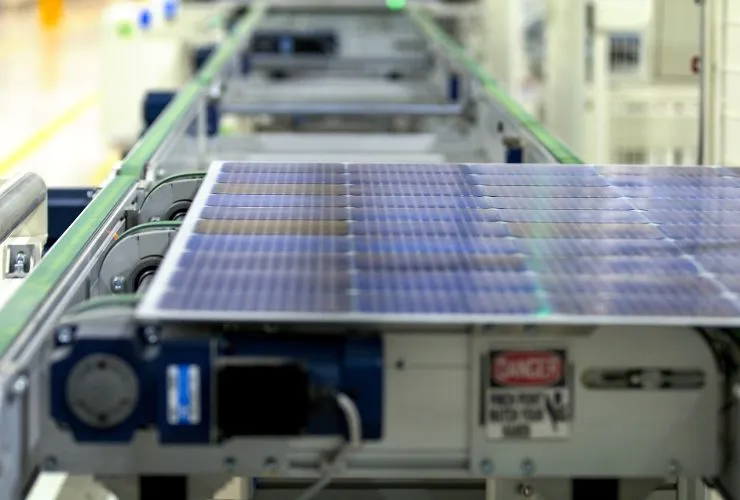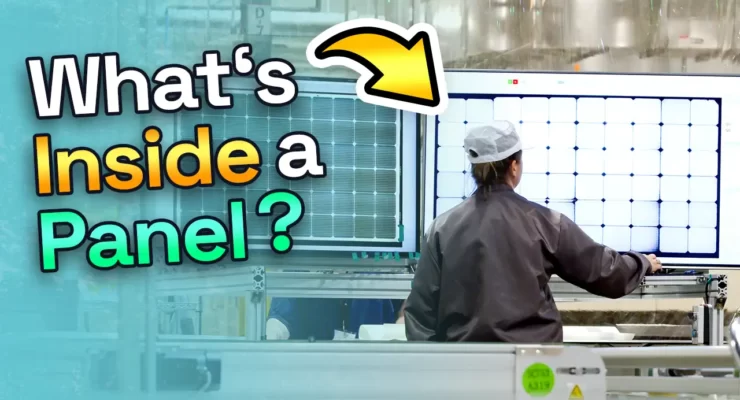Fast read
Solar panels consist of essential materials and components, with the solar cell being the central element that converts sunlight into electricity. Silicon, in the form of monocrystalline or polycrystalline cells, is commonly used because of its excellent electrical properties.
These cells are protected by a backing material, usually polymer or glass-based, and covered with tempered glass to allow sunlight transmission while shielding from debris. The panels are framed with lightweight and corrosion-resistant aluminium for structural support. Other components like junction boxes, connectors, and wiring facilitate electrical connections and integration.
As solar energy technology evolves, researchers explore new materials and manufacturing techniques to enhance efficiency, lower costs, and promote sustainability. Thin-film solar cells are made with materials like cadmium telluride (CdTe) or copper indium gallium selenide (CIGS). These cells have benefits such as flexibility and using less material. These advancements contribute to a cleaner and more sustainable energy future.
What materials are used to make solar panels?
Solar panels are like magic boxes that turn sunlight into electricity. They’re made up of different parts that all work together to do this job excellently.
The main part of a solar panel is the PV cells. These cells are made of a material called silicon. When sunlight hits these cells, they turn the sunlight into electricity. The frame around the cells is usually made of lightweight metal like aluminium. It keeps everything safe and sturdy.
On top of the cells, there’s a layer of strong glass. This glass protects the cells from bad weather like rain and snow but still lets the sunlight through.
Underneath, there’s a layer called the back sheet. It keeps everything dry and safe from moisture.
The Junction box and other components
Also at the back of the panel is a box called the junction box. This box collects all the electricity made by the cells. Inside, there are special parts called bypass diodes that make sure the panel works well even if part of it is in the shade.
Some other important parts are the encapsulants, which seal the cells and protect them. They’re usually made of special plastic. And then there are the busbars and ribbons, which are like wires that connect the cells together. They help collect all the electricity and send it out of the panel.
Outside the panel, there’s something called an inverter. It changes the electricity from the panel into the kind of electricity we use in our homes. To keep the panel in place, there are brackets and rails that hold it on the roof or the ground.
So, solar panels have lots of parts working together. Each part has a job to do, from capturing sunlight to turning it into usable electricity. Understanding these parts helps us see how solar panels can give us clean and renewable energy for our homes and businesses.
Solar cells
The solar cell, often referred to as a photovoltaic (PV) cell, is the essential component that makes solar panels work. Like the engine of a car, it drives the entire system by converting sunlight into electricity. These cells are crafted from semiconducting materials, with silicon being the star of the show. Silicon is abundant on Earth, making up about a quarter of the planet’s crust, which is why it’s widely used in solar panel manufacturing.
Silicon’s remarkable electrical properties are what make it ideal for solar cells. When sunlight hits the silicon in a solar cell, it energises the electrons, allowing them to move freely. This movement creates an electric current, which is then captured and collected for use as electricity. Silicon’s ability to efficiently convert sunlight into power is crucial for the performance and efficiency of solar panels.
The two main types of silicon used in solar cells are monocrystalline and polycrystalline silicon.
Monocrystalline vs polycrystalline solar panels
Polycrystalline silicon cells have lots of tiny crystals, while monocrystalline cells have one single large crystal. Monocrystalline silicon cells are better at turning sunlight into electricity, but they cost more to make. Polycrystalline cells are cheaper, but they’re a bit less efficient.
Solar cells need protection from the weather and other things that can damage them. They’re usually covered with a strong material like plastic or glass. This covering keeps them safe from things like rain, dust, and bumps. It helps them last longer and work better.
So, when choosing between monocrystalline and polycrystalline cells, you have to think about how much you want to spend and how efficient you want them to be. Both types of solar panels work well, but monocrystalline cells are a bit better at making electricity. And don’t forget, the covering material is important too—it keeps the cells safe and helps them last a long time.

What other components are there?
A transparent cover is placed on the solar cells to allow sunlight to pass while still protecting the cells from debris. Tempered glass is the most commonly used material for the cover. It is exceptionally durable and resistant to impact and temperature fluctuations. By minimising reflections and maximising light transmission, the glass cover also helps optimise the sunlight reaching the solar cells.
Solar panels have a frame to hold all the components together and provide structural support. Aluminium is commonly used for the frame because panels are lightweight and because of corrosion resistance and structural strength. Aluminium frames are incredibly inexpensive to produce and install, making them a popular alternative for solar panel construction.
Did we miss anything?
Solar panel technology is always getting better, thanks to ongoing research and development. Scientists and engineers are always looking for new ways to make solar panels more efficient, cheaper, and greener. One area of innovation is in the materials used to make the solar cells. Traditional silicon cells are still popular, but there are newer types of cells made from thin films of materials like cadmium telluride (CdTe) or copper indium gallium selenide (CIGS).
Thin-film solar cells have some advantages over traditional silicon cells. They are more flexible, which means they can be used in more places and even on curved surfaces. They also use less material, making them lighter and potentially cheaper to produce. These thin-film technologies are exciting because they could make solar panels more versatile and accessible, opening new possibilities for solar energy use.
In addition to the solar cells themselves, there are other components that play important roles in a solar panel system. Junction boxes, connectors, and wiring are essential for connecting the solar cells together and integrating them into a working system. These components may seem small, but they are crucial for ensuring that the electricity generated by the solar cells can be collected and used effectively.
As solar technology continues to advance, there is a growing focus on finding ways to increase efficiency and lower costs. New materials and manufacturing techniques are constantly being researched and tested to achieve these goals. This ongoing innovation is not only making solar panels more affordable but also helping to make solar energy a more viable and sustainable option for powering our world.



